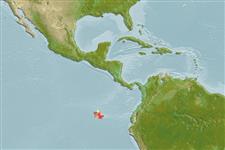Environment: milieu / climate zone / depth range / distribution range
Ecologia
marino associati a barriera corallina; distribuzione batimetrica 0 - 10 m (Ref. 57883). Tropical
Southeast Pacific: Galapagos Islands.
Size / Peso / Age
Maturity: Lm ? range ? - ? cm
Max length : 7.0 cm TL maschio/sesso non determinato; (Ref. 11482)
Raggi dorsali molli (totale): 68-80; Raggi anali molli: 51 - 59; Vertebre: 39 - 43. This species is characterized by the following: vertebrae 11-12 + 27-31 = 39-43, dorsal fin rays 68-80, anal fin rays 51-59; outer pseudoclasper with a broad base and long supporter with sharp, pointed tip; inner pseudoclasper is anteriorly inclined, of about length of outer pseudoclasper, with sharp, spine-like tip anteriorly and fleshy flap posteriorly; isthmus between pseudoclaspers wide, penis with abrupt change in thickness; opercular spine with a single, sharp tip; cheeks naked or with few isolated scales (less than 10 scales all together); otolith length: height ratio 2.1-2.2; upper preopercular pore absent (Ref. 57883).
Inhabits rocky crevices (Ref. 11482). Two paratypes that were collected at low tide between blocks of lava in about 50 cm of water, were observed to move slowly close to the sand bottom. Experiments that were carried out showed that O. deroyi can tolerate a wide
variation in salinity, but not the low salinity in which O. galapagosensis lives. Consequently, there is an ecological barrier separating the two species. Only about five embryos were observed in ripe females (Ref. 57883).
Life cycle and mating behavior
Maturità | Riproduzione | Deposizione | Uova | Fecundity | Larve
Møller, P.R., W. Schwarzhans and J.G. Nielsen, 2005. Review of the American Dinematichthyini (Teleostei: Bythitidae). Part II. Ogilbia. aqua, J. Ichthyol. Aquat. Biol. 10(4):133-207. (Ref. 57883)
IUCN Red List Status (Ref. 130435)
Threat to humans
Harmless
Human uses
Pesca: di nessun interesse
Informazioni ulteriori
Nomi ComuniSinonimiMetabolismoPredatoriEcotossicologiaRiproduzioneMaturitàDeposizioneSpawning aggregationFecundityUovaEgg development
BibliografiaAcquacolturaProfilo di acquacolturaVarietàGeneticaElectrophoresesEreditarietàMalattieElaborazioneNutrientsMass conversion
CollaboratoriImmaginiStamps, Coins Misc.SuoniCiguateraVelocitàModalità di nuotoArea branchialeOtolithsCervelliVista
Strumenti
Special reports
Download XML
Fonti Internet
Estimates based on models
Preferred temperature (Ref.
123201): 23.6 - 24.6, mean 23.9 °C (based on 12 cells).
Phylogenetic diversity index (Ref.
82804): PD
50 = 0.5000 [Uniqueness, from 0.5 = low to 2.0 = high].
Bayesian length-weight: a=0.00389 (0.00180 - 0.00842), b=3.12 (2.94 - 3.30), in cm total length, based on all LWR estimates for this body shape (Ref.
93245).
Trophic level (Ref.
69278): 3.3 ±0.5 se; based on size and trophs of closest relatives
Resilienza (Ref.
120179): Basso, tempo minimo di raddoppiamento della popolazione 4.5 - 14 anni (Assuming Fec < 100).
Fishing Vulnerability (Ref.
59153): Low vulnerability (10 of 100).
